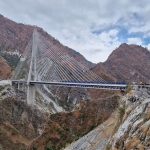India’s financial capital Mumbai will be home to the country’s first undersea tunnel by next year. National High-Speed Railway Corporation Limited (NHSRCL) invited this week bids for the construction of a 21-km-long tunnel, seven kilometers of which will be under the sea, for the Mumbai-Ahmedabad High-Speed Rail Corridor.
According to the tender document, the tunnel will be built between the underground station at Bandra-Kurla Complex and Shilphata in the Thane district of Maharashtra — thus connecting the two cities, reported PTI. The document further stated that the tunnel will be built using a tunnel boring machine and the New Austrian Tunneling Method (NATM).
Here’s all that you need to know about India’s first undersea railway tunnel:
- According to PTI, the seven-km undersea tunnel at Thane Creek will be the first undersea tunnel to come up in the country
- The tunnel will be a single-tube tunnel to accommodate twin tracks. The section will include the construction of 39 equipment rooms at 37 locations adjoining the tunnel location
- To construct this tunnel, a tunnel boring machine (TBM) with a cutter head of 13.1 meter diameter will be used. Usually, 5-6 meter diameter cutter heads are used for urban tunnels used in MRTS – Metro system, PTI reported
- Three TBMs will be used to make about 16 km of the tunnel portion and the remaining 5 km will be through NATM
- PTI further reported, this tunnel will be about 25 to 65-meter-deep from the ground level and the deepest construction point will be 114 meters below the Parsik hill near Shilphata
The bids for the design and construction of the underground Bandra Kurla Complex high-speed rail station, including a cut and cover length of 467m and ventilation shaft of 66 meters, were floated on July 22, and bid submission end date is October 22.








